
World’s First Digital Guitar FX Device
The first Harmonizer, the H910, released in 1976, was designed to sit in a rack in the studio. Within a couple of years, major acts with big budgets like Led Zeppelin, The Mothers of Invention, and Van Halen began to tour with them. Costing nearly $10,000 in today’s dollars, the H910 was far beyond the reach of, well, nearly everyone else. This was the era of primitive logic chips, and it took a small boatload of them to simply delay audio as 1s and 0s by a fraction of a second. In 1978, our founder, Richard Factor, took on the challenge of designing an ‘affordable’ Harmonizer; one that a guitar or keyboard player might take on the road.
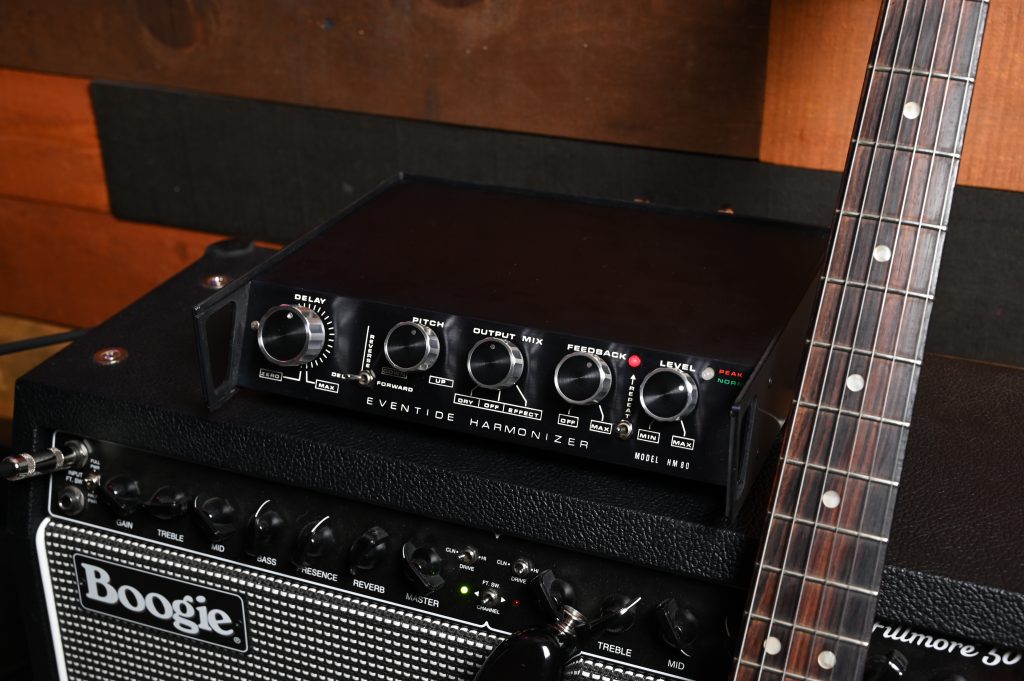
The HM80 featured guitar in, amp out, as well as performance features including expression pedal control of pitch and an auxiliary switch jack for switching the repeat function on/off. While it wasn’t a ‘stompbox’—the boatload of early power-hungry chips required more juice than a wall wart could supply, which gave us pause about putting AC at the feet of a guitarist—it predated the introduction of the first digital delay stompbox, the Boss DD-2, by nearly five years.
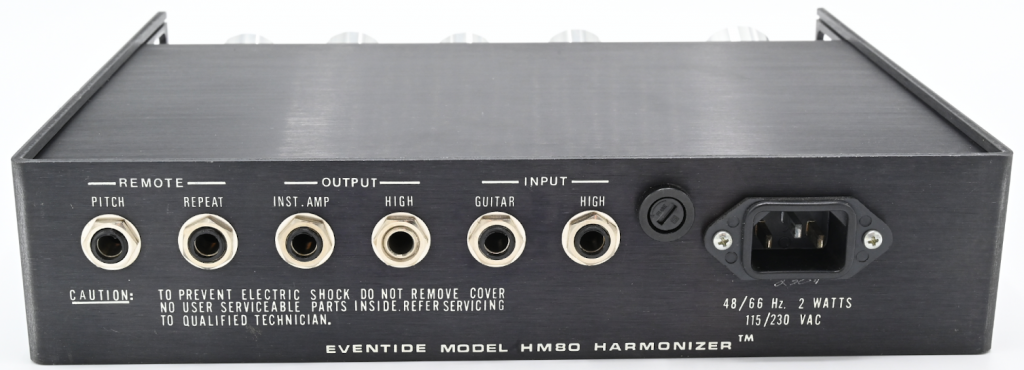
At about half the price of an H910, HM80s found their way into the hands of a few gigging musicians and composers who, for the first time, could exploit the new world of digital audio effects live. To our delight and surprise, we found out the device also made its way into the hands of students and educators through universities who couldn’t afford the H910.
We asked Richard Factor to dig deep in his memory and tell us how the first digital audio device designed for live use came to be. Here’s the story excerpted from his blog:
A Walk Down Half-Memory Lane
50th Anniversary!
The company at which I strive, Eventide Inc., has been extant for 50 years, almost to the day. That imbues us with history, and most of our early history is things called “products.” Yes, in those days tech companies made “things” instead of apps or other persuasions of intangible computer code. Our things were made of the chemical elements, of which there were somewhat fewer then. Among these elements was Silicon, and it was Good. Using newfangled “integrated circuits,” now called “chips,” we made, inter alia, products for recording studios and broadcasters. And, almost by accident, we made a product for musicians! This is the story of that product. And, it does involve half-memories.
The HM80 “Baby Harmonizer”
Until the HM80, all of our products were of the “rack-mount” persuasion. They were rigorously 19-inches wide to fit in standard studio-equipment racks. They were vertically quantized in 1-3/4 inch units with mounting holes placed in precise relation to their control panels. And they, too, were Good. The first of our Harmonizer special effects units, the model H910, sold many thousands for the now-equivalent price of nearly $10,000 each. The two-year-later model, the H949, was even more feature-laden and more expensive. But what about performing musicians? Should they be deprived of the manifold benefits of pitch change and delay? No!
At least that’s what I was thinking (in part) when I galumphed forth from our modest office, then in New York City, on my Saturday morning tour of midtown-Manhattan’s chocolate vendors. Kron! Perugina! Manon! Lindt! (The other part of my thoughts had to do with listening to bats. With pitch-change technology, I reasoned, we should be able to bring their high-frequency acoustic radar into the range of human hearing. But I digress.) Musicians were no more a prosperous lot in the ’70s than they are now. If we were going to make an affordable digital-effects product that could be used on stage, it had to be cheap, rugged, less unwieldy than our other products, enticing, and cheap. Clearly, at least one priority was twice as important as the others.
Cheap: The Priority
One reason each Instant Phaser sounded different from its conspecifics is that I could never find a reliable source of same-value capacitors without paying full distributor pricing. By haunting the surplus stores in the New York City area, I was often able to obtain remarkable bargains in hardware and components for producing our equipment. For example, the power transformer for our early delay lines was this wonderfully robust, reliable, and versatile military-surplus tar-potted brick bought for pennies on the dollar. Even our AC power cords were “special.”
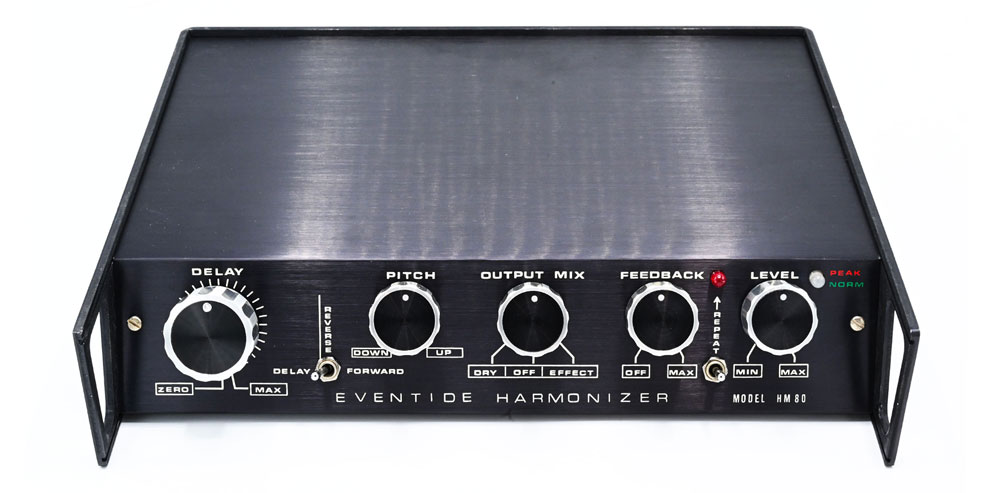
Enticing was a pretty important priority, too. One Eventide distinction—what we called “The Knob”—was featured on our rack-mount products, and it cost us about $5. We felt that it enhanced what is now called “look and feel” and, being on the front panel, it was worth it. But how could we support that kind of cost on a product with five knobs of solid aluminum, brushed metal inserts, and, as a lagniappe, a white dot for orientation? So you don’t have to peek ahead, the answer was Citizens Band Radio. As the HM80 was being designed, CB was dying. Edlie, my favorite Long Island surplus emporium, was the beneficiary of the demise of Hy-Gain, an old-line radio and antenna manufacturer that overestimated the staying power of the Breaker-19 syndrome. $5 knobs, brand new and in their original compartmented boxes, were suddenly five cents. Hallelujah, an affordable front panel!
What About Innards?
One of the biggest expenses in a number of our products was the audio digital-storage memory price. From the very first shift-register delay line to almost the present day, memory chip prices defined the economical and sometimes even the possible. Memory prices at the time were prohibitive. (Even earlier, they were as much as a dollar per byte!) At least they were hard to manufacture and often hard to get. Enter memory manufacturer Mostek, who was selling half-memories at much less than half-price. To find your data in a memory chip, you must give it the “address” which defines its location with the digital state of a number of address lines. If one of these address lines points to bad data, the chip would normally be useless. But we had a relationship with Mostek, and they asked if we could use chips with the most significant address line inoperable. Could we ever! By sacrificing half the memory capacity, we saved about 90% of the cost. Suddenly, we could afford to sell a delay line to real people and not just to flush corporations.
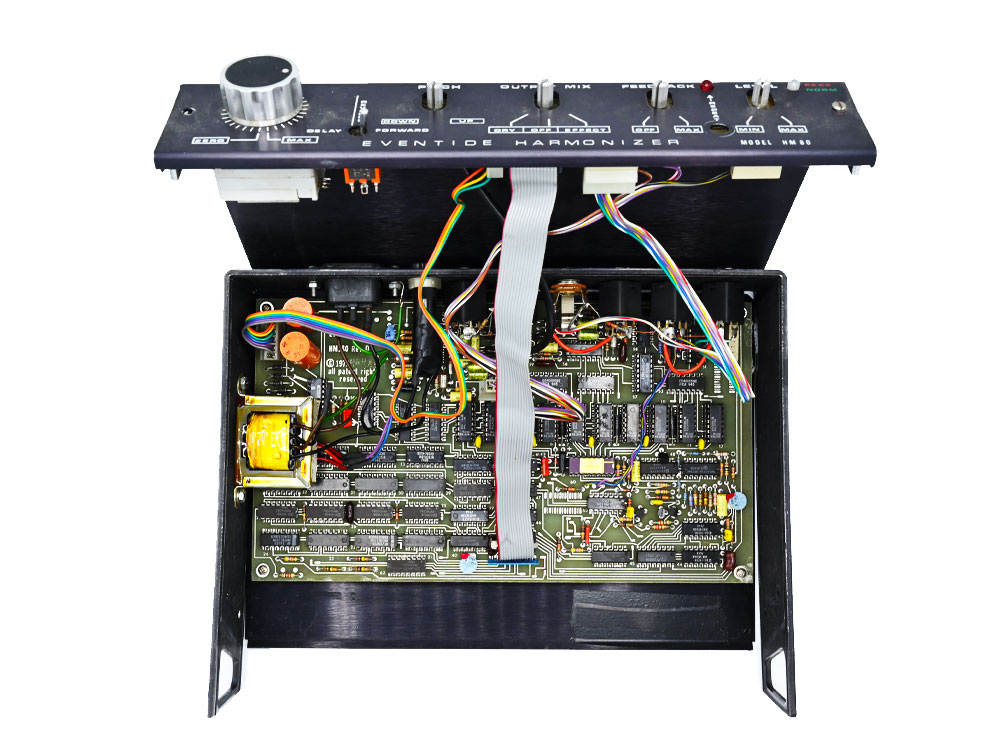
The rest of the innards were on two printed circuit boards, relatively undistinguished in their technology. Although the HM80 made ineluctable compromises in audio quality and bandwidth, it filled a need and our coffers, and was unique in that it was the first digital product designed for the performing musician.
So What Did the HM80 Do?
The panel says it all, and the manual says even more. In addition to the usual delay and pitch change functions, it did time reversal, repeat (looping), and feedback. All for less than half the price of the H910 or a quarter of the H949. Although I suspect its price-per-pound was higher than either.
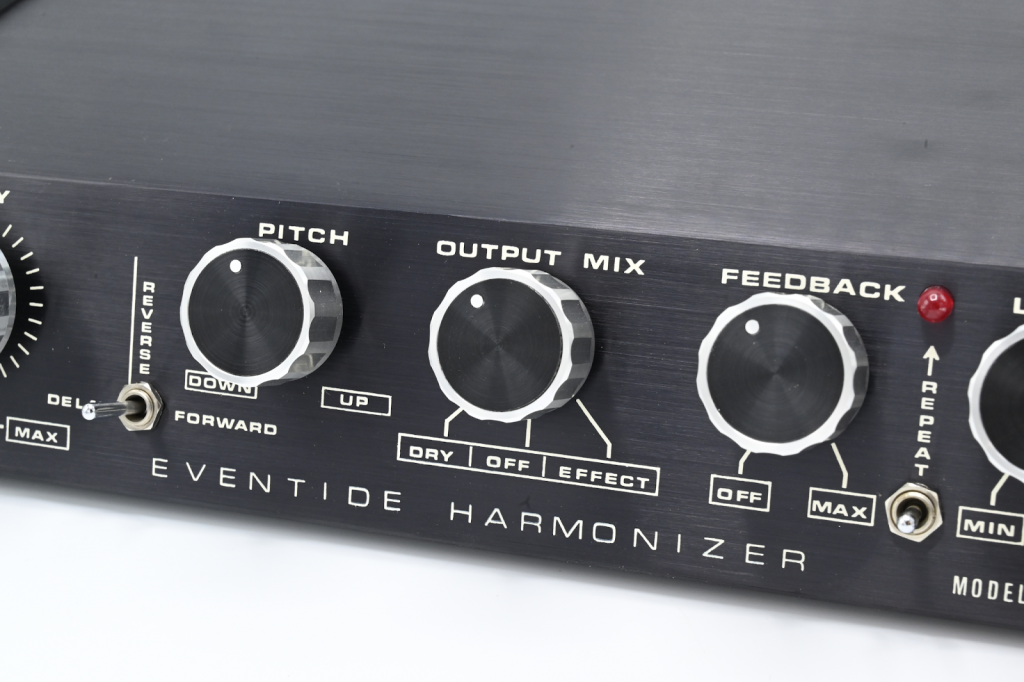
While it wasn’t an enormous seller as were those two studio products, it almost made it up to a thousand units before we ran out of knobs or customers, I’m not sure which. And it paid for a lot of subsequent chocolate walks.
Thanks for the half-memories, Richard!
How’d it Sound?
Here’s a YouTube video of the HM80 in action:
Who Used It?
In preparing this Flashback, we reached out to a number of intrepid HM80 users. Here are a few:
Laurie Spiegel: Computer Music Pioneer & Interstellar Composer
Longtime Eventide user and innovator of electronic music, Laurie Spiegel, was a fan of the HM80 in the late ’70s and ‘80s, incorporating it into her live-performance setup. In this piece performed at the New Music America Festival in 1981, which was broadcast live on NPR, she is using an Apple II computer—one of the first affordable, personal “microcomputers”—to create square waves, and sending them through an HM80. This combination of “microcomputer” plus “baby Harmonizer” resulted in expansive, yet low budget, synth sounds:
Randy Walters: Musician, Composer, and Hot Air Balloon Film Scorer
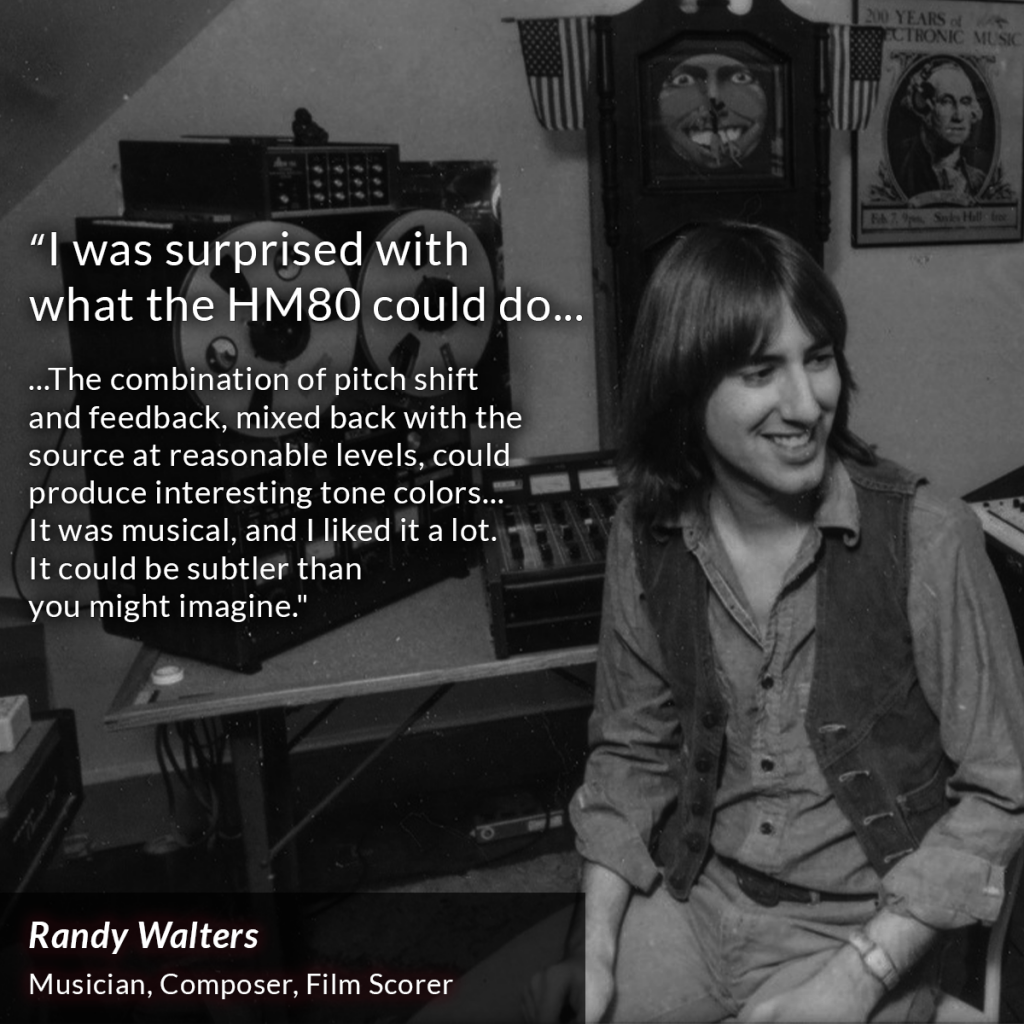
We recently had the chance to interview Randy Walters, another HM80 aficionado and graduate of Brown University’s Music Technology program, about the many projects he used the HM80 on after purchasing the device in the early ‘80s. One of these projects included a score for films about hot-air ballooning in Venezuela, which aired on the Discovery Channel’s National Geographic Explorer program. Some of the locations in the films, such as Angel Falls (the tallest waterfall in the world), would later inspire some of the scenes in Pixar’s Up! Click here to read the rest of our interview with Randy.
Professor Peter Elsea: The HM80 in the College Classroom

Peter Elsea, a composer and music technologist who taught at UC Santa Cruz from 1980 to 2013, installed an HM80 in the electronic music studios of the university when he was tasked with bringing their equipment up to date. The HM80 was a viable option and a way for the students to get hands-on experience with outboard effects. Peter and his students created experimental music from their library of recorded sounds, which ranged from cats to the cutting of aluminum plates. The HM80 allowed them to explore the many possibilities of pitch change and time modulation, and it is still being put to good use by the students to this day.
Cast Your Vote:
Do you think Eventide should reissue the HM80 today? Vote in our poll here.

Tune in to Flashback #7 as we chronologically continue along our first decade of gear. Up next, the H949…
Check out our previous flashbacks!
- Flashback #1: The Instant Phaser
- Flashback #2.1: The DDL 1745 Delay
- Flashback #2.2: The DDL 1745A Delay
- Flashback #2.3: The DDL 1745M Delay
- Flashback #3: The Omnipressor®
- Flashback #4.1: The H910 Harmonizer®
- Flashback #4.2: H910 Harmonizer® — The Product
- Flashback #4.3: H910 Harmonizer® — “Minds Blown”
- Flashback #5: FL 201 Instant Flanger
- Flashback #6: HM80 — The Baby Harmonizer®
- Flashback #7.1: The H949 Harmonizer®
- Flashback #7.2: H949 Harmonizer® — The New One
- Flashback #7.3: H949 Harmonizer® — Bending, Stretching, and Twisting Time
- Flashback #8: H969 Harmonizer®
- Flashback #9.1: Broadcast
- Flashback #9.2: Dump & Go – The Profanity Delay
- Flashback #10: Thinking Outside the Black Box


